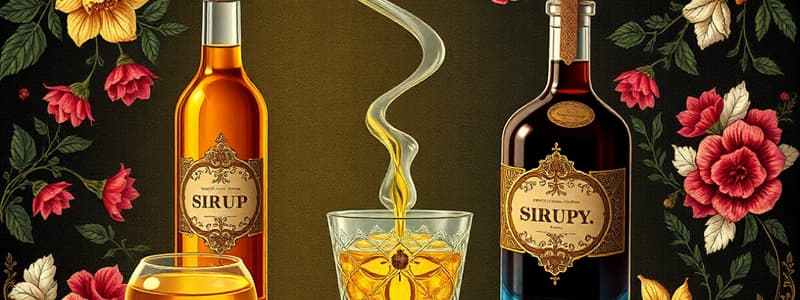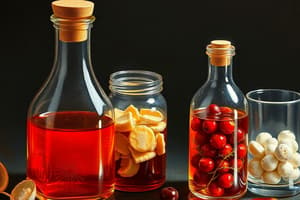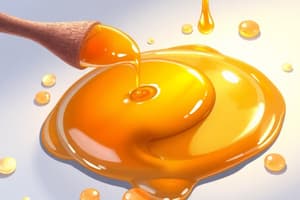Podcast
Questions and Answers
What is the primary purpose of syrups in pharmaceutical technology?
What is the primary purpose of syrups in pharmaceutical technology?
- To serve as pleasant tasting vehicles for medicinal substances (correct)
- To enhance the color of medications
- To function as a diagnostic tool
- To create solid dosage forms
Nonmedicated syrups contain medicinal agents.
Nonmedicated syrups contain medicinal agents.
False (B)
What type of syrup is used to help administer bitter-tasting drugs to children?
What type of syrup is used to help administer bitter-tasting drugs to children?
Cocoa syrup
Syrups containing flavoring agents but not medicinal substances are called __________.
Syrups containing flavoring agents but not medicinal substances are called __________.
Match the following syrups with their characteristics:
Match the following syrups with their characteristics:
Which of the following ingredients is NOT typically used in the preparation of medicated syrups?
Which of the following ingredients is NOT typically used in the preparation of medicated syrups?
Medicated syrups can only contain water-soluble drugs that are stable in aqueous solution.
Medicated syrups can only contain water-soluble drugs that are stable in aqueous solution.
A typical syrup contains __________% sucrose in purified water.
A typical syrup contains __________% sucrose in purified water.
What is the primary sugar used in most syrups?
What is the primary sugar used in most syrups?
Thick syrups can provide a soothing effect on irritated throat tissues.
Thick syrups can provide a soothing effect on irritated throat tissues.
What is the active alkaloid found in ipecac that is responsible for its emetic properties?
What is the active alkaloid found in ipecac that is responsible for its emetic properties?
Name one non-sucrose substance that can be used in syrups for diabetic patients.
Name one non-sucrose substance that can be used in syrups for diabetic patients.
Most syrups typically contain ___________ preservatives.
Most syrups typically contain ___________ preservatives.
The usual dose of syrup of ipecac for children is 30 mL.
The usual dose of syrup of ipecac for children is 30 mL.
Match the following syrup components to their purposes:
Match the following syrup components to their purposes:
What is the primary use of syrup of ipecac?
What is the primary use of syrup of ipecac?
Which of the following substances is NOT typically used in syrups?
Which of the following substances is NOT typically used in syrups?
The syrup of ipecac can build up to toxic levels of ______ in the body with continual use.
The syrup of ipecac can build up to toxic levels of ______ in the body with continual use.
Dilute sucrose solutions are resistant to microbial growth.
Dilute sucrose solutions are resistant to microbial growth.
Match the following syrups with their primary usage:
Match the following syrups with their primary usage:
What percentage of sucrose is commonly found in most syrups?
What percentage of sucrose is commonly found in most syrups?
The viscosity of syrups is largely a result of the presence of __________.
The viscosity of syrups is largely a result of the presence of __________.
What effect does a thick syrup have on the taste perception of medications?
What effect does a thick syrup have on the taste perception of medications?
What is the primary component dissolved in Syrup, NF?
What is the primary component dissolved in Syrup, NF?
The specific gravity of Syrup, NF is less than 1.
The specific gravity of Syrup, NF is less than 1.
What is the weight of 100 mL of Syrup, NF?
What is the weight of 100 mL of Syrup, NF?
The excess water used to prepare Syrup, NF is about _____ mL.
The excess water used to prepare Syrup, NF is about _____ mL.
What is the primary reason for adding preservatives to some syrups?
What is the primary reason for adding preservatives to some syrups?
Syrup, NF can be stored without preservatives if used soon after preparation.
Syrup, NF can be stored without preservatives if used soon after preparation.
How much sucrose is used to make Syrup, NF?
How much sucrose is used to make Syrup, NF?
Match the following components with their quantities in Syrup, NF preparation:
Match the following components with their quantities in Syrup, NF preparation:
What happens if the syrup becomes completely saturated with sucrose?
What happens if the syrup becomes completely saturated with sucrose?
The solubility of sucrose is _____ in mL of water.
The solubility of sucrose is _____ in mL of water.
What is a benefit of using boiled purified water in syrup preparation?
What is a benefit of using boiled purified water in syrup preparation?
Agitation without heat is quicker than using heat in syrup preparation.
Agitation without heat is quicker than using heat in syrup preparation.
What should be done with solid agents before adding them to syrup?
What should be done with solid agents before adding them to syrup?
The process of filtering out water-insoluble agents from a tincture is called _____ resting.
The process of filtering out water-insoluble agents from a tincture is called _____ resting.
Match the following syrup preparation methods with their descriptions:
Match the following syrup preparation methods with their descriptions:
Which sweetening agent is often employed in syrups if not sucrose?
Which sweetening agent is often employed in syrups if not sucrose?
Syrup should be stored in a loose container to maintain quality.
Syrup should be stored in a loose container to maintain quality.
What type of liquids may be used as a source of medication in syrup preparation?
What type of liquids may be used as a source of medication in syrup preparation?
The _____ method is used to prepare syrup by passing sucrose through a column.
The _____ method is used to prepare syrup by passing sucrose through a column.
What is the main reason for removing alcohol-soluble components in some syrup preparations?
What is the main reason for removing alcohol-soluble components in some syrup preparations?
Flashcards are hidden until you start studying
Study Notes
Syrups Overview
- Concentrated aqueous solutions of sugar or sugar substitutes, with or without flavoring agents and medicinal substances.
- Used to mask unpleasant tastes of medications, especially for children and elderly.
- Nonmedicated syrups are used as flavored vehicles (e.g., Cherry syrup, Cocoa syrup, Orange syrup, Raspberry syrup).
- Medicated syrups contain a medicinal agent and are used for therapeutic purposes.
Syrup Components
- Sugar: Typically sucrose, provides sweetness and viscosity.
- Antimicrobial preservatives: Prevent microbial growth.
- Flavorants: Enhance palatability.
- Colorants: Improve aesthetic appeal.
Sucrose- and Non-Sucrose-Based Syrups
- Sucrose is the most common sugar used in syrups.
- Alternatives to sucrose:
- Sorbitol, glycerin, propylene glycol: May be used in whole or in part to replace sucrose.
- Methylcellulose, hydroxy ethylcellulose: Non-glycogenetic substitutes for use in diabetic patients.
- High sucrose concentration limits microbial growth due to water unavailability, enhancing syrup stability.
Syrup Preparation Methods
- Solution by Agitation Without Heat: Preferable for maintaining sucrose stability.
- Addition of Sucrose to a Medicated Liquid or to a Flavored Liquid: Useful for tinctures and fluidextracts.
- Percolation: Involves extracting medicinal components and adding to a sucrose solution.
- Example: Ipecac syrup, prepared by percolation and used as an emetic.
- Syrups are typically stored in tight containers to maintain stability.
Examples of Common Syrups
- Bromhexine syrup: Treats respiratory disorders with excessive mucus.
- Salbutamol syrup: A bronchodilator that eases breathing.
- Samilin, Tussilet: Cough preparations containing different ingredients.
Studying That Suits You
Use AI to generate personalized quizzes and flashcards to suit your learning preferences.




